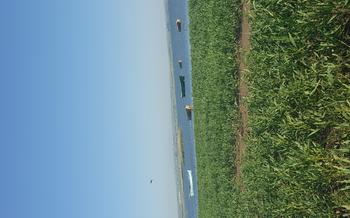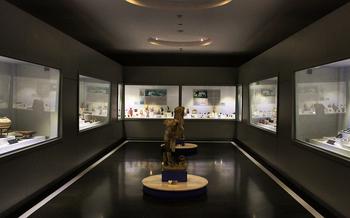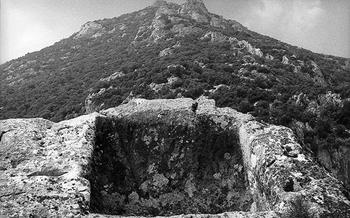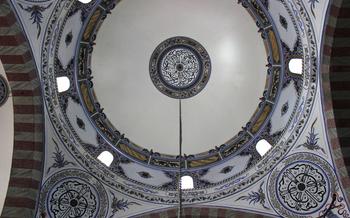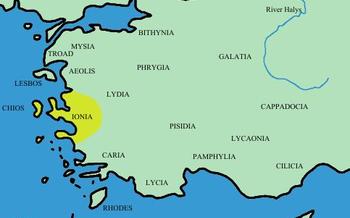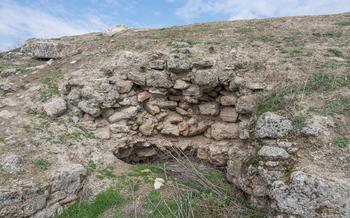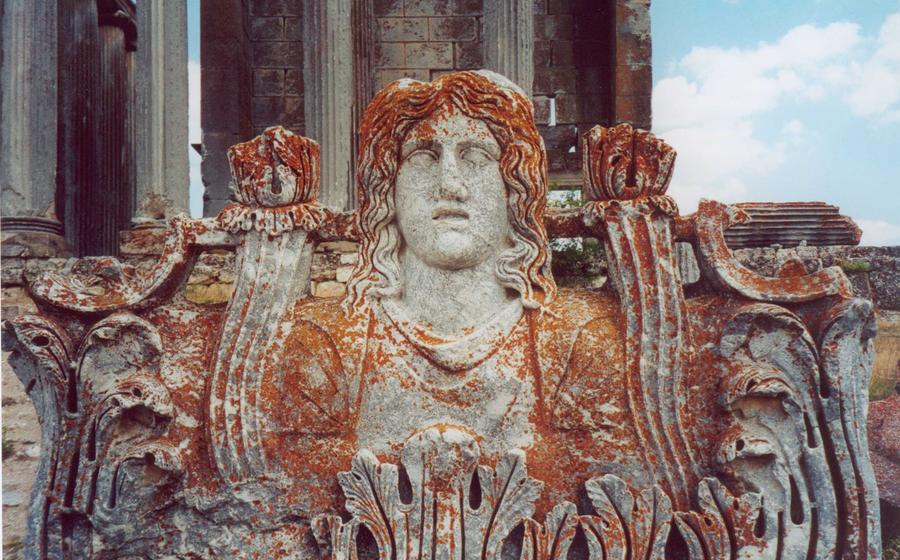
Aizanoi Ancient City
- Exploring the Well-Preserved Ruins
- Marveling at the Temple of Zeus
- Stepping into the Ancient Theater
- Discovering the Ancient Stadium
- Strolling Through the Agora
- Unveiling the Necropolis
- Visiting the Aizanoi Museum
- Taking a Guided Tour
- Choosing the Best Time to Visit
- Planning Your Visit:
- Transportation to Aizanoi:
- Accommodation and Dining Options:
- Combining Aizanoi with Other Attractions
- A Hidden Gem Within Aizanoi
Exploring the Well-Preserved Ruins
Aizanoi boasts an impressive array of well-preserved ruins that offer a glimpse into the grandeur and sophistication of this ancient city. Among the highlights is the Temple of Zeus, an awe-inspiring structure that dominates the site. With its towering columns and intricate carvings, it stands as a testament to the architectural prowess of the ancient Greeks.
Equally impressive is the ancient theater, renowned for its exceptional acoustics and seating capacity of over 20,000 spectators. Imagine attending ancient performances or theatrical productions in this magnificent setting, where the actors' voices would have resonated clearly throughout the auditorium.
The ancient stadium, with its elongated shape and tiered seating, invites visitors to picture the excitement of chariot races or gladiator contests. These events would have drawn massive crowds, eager to witness the spectacle and cheer on their favorites.
Finally, the agora, the ancient marketplace, offers a glimpse into the bustling commercial and social life of Aizanoi. Here, visitors can explore the ruins of shops, temples, and other buildings that once lined the square, imagining the hustle and bustle of trade and the social interactions that took place within these walls.
Marveling at the Temple of Zeus
Aizanoi's most prominent and awe-inspiring structure is undoubtedly the Temple of Zeus, a testament to the city's grandeur and architectural prowess. Dedicated to the king of the gods, the temple exudes an air of divinity and commands attention with its sheer size and intricate details.
Constructed in the 2nd century AD, the temple showcases a remarkable blend of Greek and Roman architectural influences. Its towering columns, each adorned with intricate carvings, seem to reach towards the heavens, creating a sense of awe and reverence. The temple's facade is a masterpiece of artistry, featuring elaborate friezes depicting scenes from Greek mythology, including the battle between the gods and giants.
Step inside the temple, and you'll be greeted by a vast and solemn interior. The air is filled with a sense of history and spirituality, as if the gods themselves once walked these hallowed halls. Marvel at the intricate mosaics that adorn the floor, each tile telling a story from ancient mythology.
Take a moment to reflect on the religious and cultural significance of the Temple of Zeus in ancient Aizanoi. This was a place where people came to worship, to seek guidance, and to connect with the divine. The temple was the heart of the city's religious life, and its presence continues to evoke a sense of wonder and reverence to this day.
Stepping into the Ancient Theater
The ancient theater of Aizanoi is a marvel of architectural acoustics, capable of amplifying even the slightest whisper to the farthest reaches of its vast seating area. Imagine attending an ancient performance, where the actors' voices carried effortlessly across the tiers, creating an immersive and intimate atmosphere. The theater's remarkable design allowed every spectator to feel connected to the action on stage, fostering a sense of collective engagement and emotional resonance.
Explore the backstage areas of the theater to discover the intricate mechanisms that facilitated scene changes and special effects. Learn about the ingenious use of curtains, pulleys, and rotating stages that allowed for seamless transitions and dramatic reveals. These behind-the-scenes insights offer a glimpse into the creativity and technical prowess of ancient theater makers.
Reflect on the cultural and social significance of theater in ancient Aizanoi. It was not merely a form of entertainment but also a platform for storytelling, education, and social commentary. Plays addressed contemporary issues, explored moral dilemmas, and celebrated the achievements of the city. The theater served as a vibrant space for community gatherings, fostering a sense of shared identity and cultural connection.
Discovering the Ancient Stadium
Venturing into the ancient stadium of Aizanoi is like stepping back in time to an era of exhilarating chariot races and fierce gladiator contests. The stadium, an impressive testament to the city's sporting prowess, boasts a vast expanse that could accommodate thousands of spectators. Imagine the roar of the crowd as chariots thundered around the track, their wheels kicking up dust and the air thick with anticipation.
The design of the stadium is a marvel of engineering, with tiers of stone seating rising from the arena floor. The meticulous arrangement of the seats ensures that every spectator had an unobstructed view of the action. As you explore the stadium, let your imagination run wild, picturing the fierce battles between gladiators, their swords clashing and the crowd erupting in cheers or jeers.
Beyond the entertainment aspect, the stadium also played a significant role in ancient society. It served as a venue for athletic competitions, which were not only a display of physical prowess but also a symbol of civic pride. These events fostered a sense of unity and rivalry among the citizens of Aizanoi, strengthening the bonds that held their community together.
Whether you're a history buff, a sports enthusiast, or simply someone who appreciates the grandeur of ancient architecture, the stadium at Aizanoi is an unmissable attraction. Take a moment to sit on the worn stone seats, close your eyes, and let the echoes of the past transport you to a time when the stadium was filled with the roar of the crowd and the spectacle of ancient sports.
Strolling Through the Agora
In the heart of ancient Aizanoi, the agora served as the bustling marketplace and social hub of the city. Step into its well-preserved ruins and let your imagination transport you back in time. Picture the vibrant atmosphere as merchants displayed their wares, shoppers haggled for the best prices, and locals gathered to exchange news and socialize.
Explore the remains of shops that once lined the agora, each with its unique character. Imagine the sounds of bargaining, the clinking of coins, and the laughter of friends meeting in the shade of the colonnades. Discover the temples and other public buildings that surrounded the agora, adding to its grandeur and importance.
Reflect on the economic and social significance of the agora in ancient Aizanoi. It was not just a place of commerce but also a center of civic life, where people came together to conduct business, discuss politics, and celebrate religious festivals. The agora was the beating heart of the city, connecting people from all walks of life and fostering a sense of community.
Unveiling the Necropolis
Journey beyond the bustling streets of ancient Aizanoi to discover its necropolis, an ancient cemetery that whispers tales of life and death in this once-thriving city. Located on the outskirts of the site, the necropolis offers a poignant glimpse into the beliefs and rituals of the people who called Aizanoi home.
Explore the diverse array of tombs that dot the landscape, each a testament to the unique lives of those laid to rest here. From simple rock-cut chambers to elaborate sarcophagi adorned with intricate carvings, these tombs reveal the social hierarchy and cultural practices of ancient Aizanoi.
Learn about the various burial customs practiced by the city's inhabitants. Discover the significance of cremation and inhumation, and witness the evolution of tomb design over time. Unearth the secrets of the grave goods buried alongside the deceased, offering insights into their worldly possessions and beliefs about the afterlife.
Reflect on the continuity of life and death, as the necropolis serves as a reminder of the inevitable end that awaits us all. Yet, amidst the somberness, find solace in the enduring legacy of Aizanoi's people, whose stories live on through the remnants of their final resting place.
Visiting the Aizanoi Museum
The Aizanoi Museum, located within the ancient city, is a treasure trove of artifacts and exhibits that offer a glimpse into the daily life, culture, and art of ancient Aizanoi. This modern museum houses a rich collection of sculptures, pottery, coins, jewelry, and other objects excavated from the site.
As you wander through the museum's galleries, you'll be captivated by the intricate carvings and delicate pottery that adorned the homes and temples of Aizanoi's inhabitants. The statues and busts provide a glimpse into the faces and expressions of the people who lived here centuries ago.
One of the highlights of the museum is the collection of coins, which depict various rulers and deities from the ancient world. These coins not only shed light on the economic and political history of Aizanoi but also serve as beautiful examples of ancient craftsmanship.
The museum also features a section dedicated to the archaeological excavations and research conducted at Aizanoi. Here, you can learn about the methods and techniques used by archaeologists to uncover the secrets of this ancient city.
Visiting the Aizanoi Museum is an essential complement to your exploration of the ancient city. It provides a deeper understanding of the culture, history, and art of Aizanoi, bringing the ruins to life and allowing you to connect with the people who once called this place home.
Taking a Guided Tour
Exploring Aizanoi with a knowledgeable guide is an enriching experience that amplifies your understanding of this ancient city. Guides bring the site to life, sharing historical anecdotes, mythological tales, and cultural insights that would otherwise go unnoticed. They point out hidden details, explain the significance of architectural features, and provide context to the artifacts you encounter.
Join a guided tour to delve deeper into the history, mythology, and cultural significance of Aizanoi. Learn about the city's origins, its role in the Roman Empire, and its eventual decline. Discover the stories behind the ruins, the people who inhabited them, and the events that shaped their lives.
Guides also offer insider tips and recommendations, ensuring you make the most of your visit. They can suggest the best vantage points for photography, guide you to lesser-known areas, and help you avoid the crowds. By sharing experiences and insights with fellow travelers, you'll gain diverse perspectives and create lasting memories.
Choosing the Best Time to Visit
Aizanoi welcomes visitors year-round, but certain times offer unique advantages. For pleasant weather and fewer crowds, spring (April-May) and fall (September-October) are ideal. The temperatures are mild, allowing for comfortable exploration of the outdoor ruins. Capture stunning photographs with the vibrant autumn foliage as a backdrop.
Summer (June-August) can be hot and crowded, but it's an excellent time to experience Aizanoi's lively atmosphere. While the heat can be intense, the ancient ruins provide respite from the sun's rays. Plan your visit early in the morning or late in the afternoon to avoid the midday heat.
Winter (November-March) offers a tranquil experience with fewer visitors. While the weather can be chilly, the site's beauty takes on a different charm under a dusting of snow. Explore the ruins at your own pace and immerse yourself in the serenity of the ancient city.
Planning Your Visit:
Planning a visit to Aizanoi requires careful consideration to ensure a rewarding and enjoyable experience. Allocate sufficient time to explore the entire site, as its vastness and intricate details demand a leisurely pace. Comfortable shoes are a must for navigating the uneven terrain and cobblestone paths. Protection from the sun is essential, particularly during the summer months when temperatures can soar.
Pack water and snacks to stay hydrated and energized, as food options on-site are limited. Consider bringing a camera to capture the stunning grandeur of the ancient ruins and the picturesque landscapes surrounding them. For a more in-depth understanding of the site's history and significance, consider hiring a knowledgeable guide or joining an organized tour.
Whether you choose to explore independently or with a guide, be prepared to be amazed by the architectural wonders and rich history that Aizanoi has to offer. Immerse yourself in the atmosphere of this ancient city, and let your imagination transport you back in time to a world of gods, gladiators, and chariot races.
Transportation to Aizanoi:
Reaching Aizanoi from major cities in Turkey is relatively straightforward. If you prefer the flexibility of exploring at your own pace, renting a car is a convenient option. Several car rental agencies are available in cities like Istanbul, Ankara, and Izmir, offering a wide range of vehicles to suit your needs. The drive to Aizanoi from these cities takes approximately 4-6 hours, depending on traffic and road conditions.
For those who prefer not to drive, public transportation is also a viable option. Regular buses connect Aizanoi to nearby towns and cities, including Kütahya, Bursa, and Eskişehir. The bus journey from Kütahya to Aizanoi takes about 1 hour and 30 minutes. Once you arrive at the Aizanoi bus station, you can easily walk to the ancient city, which is just a short distance away.
If you want a hassle-free experience, consider joining an organized tour that includes transportation to and from Aizanoi. Several tour operators offer day trips or multi-day itineraries that combine visits to Aizanoi with other attractions in the region. This option is ideal for those who want to learn more about the history and culture of the ancient city from knowledgeable guides.
To navigate the local transportation system, it's helpful to learn a few basic Turkish phrases, such as "Merhaba" (hello) and "Teşekkür ederim" (thank you). English is not widely spoken in smaller towns and villages, so having a translation app or phrasebook on hand can be beneficial.
Accommodation and Dining Options:
Aizanoi itself offers limited accommodation options for visitors. However, several nearby towns and cities provide a wider range of hotels and guesthouses to suit different budgets and preferences. Kütahya, located approximately 45 kilometers from Aizanoi, is a good base for exploring the ancient city. It offers a variety of hotels, from budget-friendly options to comfortable mid-range hotels, as well as several restaurants serving traditional Turkish cuisine.
For a more immersive experience, consider staying in a traditional Turkish guesthouse or "pansiyon." These guesthouses often offer a glimpse into local life and culture, with cozy rooms and home-cooked meals.
When it comes to dining, Aizanoi has limited options, with only a few cafes and restaurants catering to visitors. To savor the authentic flavors of Turkish cuisine, venture into nearby towns or cities, where you'll find a wider selection of restaurants offering traditional dishes, fresh seafood, and delectable kebabs.
For those with dietary restrictions, vegetarian and vegan-friendly options may be limited in the immediate vicinity of Aizanoi. However, larger towns like Kütahya offer a better selection of restaurants that cater to various dietary needs. It's always a good idea to research and plan ahead to ensure you have access to suitable dining options during your stay.
Combining Aizanoi with Other Attractions
Aizanoi is not the only captivating destination in the region. Consider expanding your itinerary to include other historical and natural wonders nearby. Just an hour's drive away lies the awe-inspiring Hierapolis, an ancient city built on top of hot springs. Explore its well-preserved ruins, including the magnificent theater and the impressive Necropolis.
For a change of scenery, head to the stunning Lake Salda, often referred to as the Maldives of Turkey. Immerse yourself in the crystal-clear turquoise waters and soak up the sun on the pristine white beaches. The lake's unique mineral composition and white travertine terraces create an otherworldly landscape that is sure to leave you spellbound.
Enrich your journey further by visiting the ancient city of Pergamon, with its impressive Acropolis and the Asclepion, a renowned healing center in antiquity. Discover the mesmerizing Pamukkale, also known as the Cotton Castle, where cascading white travertine terraces and thermal pools create a breathtaking spectacle.
Combining Aizanoi with these other attractions allows you to delve deeper into the region's rich history, natural beauty, and cultural heritage. Create a diverse itinerary that caters to your interests and passions, ensuring an unforgettable and enriching travel experience.
A Hidden Gem Within Aizanoi
Beyond the main attractions of Aizanoi, there lies a hidden gem waiting to be discovered. Nestled amidst the ruins, a serene garden flourishes, offering a tranquil escape from the bustling ancient city. As you venture into this secret sanctuary, you'll be greeted by a tapestry of vibrant flowers, aromatic herbs, and shady trees. Take a moment to pause and soak in the tranquility, allowing the beauty of nature to transport you back in time.
This hidden garden is a testament to the enduring spirit of Aizanoi. Despite the passage of centuries, the city's essence remains alive in the vibrant colors and sweet fragrances that permeate the air. As you explore the garden, imagine the ancient inhabitants tending to their own plants, finding solace and inspiration in the midst of their bustling urban life.
Whether you seek a moment of solitude or a chance to connect with the past, this hidden garden is an oasis of tranquility that awaits your discovery. Let the magic of Aizanoi envelop you as you wander through its secret paths, uncovering the hidden treasures that lie beyond the main attractions.
